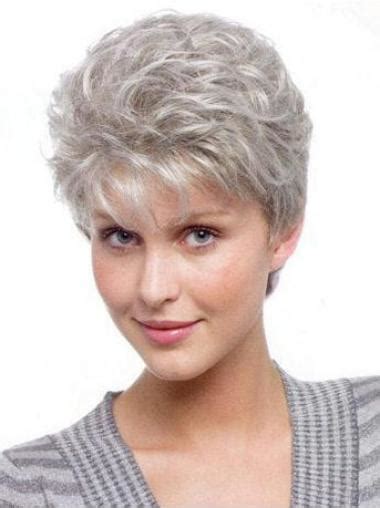With the rising number of elderly women seeking stylish and convenient hair solutions, the demand for wigs specifically tailored to their needs has skyrocketed. According to a recent survey by the National Council on Aging, over 50% of women over the age of 65 experience significant hair loss due to aging, medical conditions, or genetic factors. This guide will explore the benefits, types, and considerations for choosing wigs for elderly women, helping them enhance their appearance and regain their confidence.

Benefits of Wigs for Elderly Women
- Improved Appearance: Wigs can conceal hair loss and thinning, providing a fuller, more youthful look. They can also help to frame the face, accentuate features, and enhance overall style.
- Increased Confidence: Wearing a wig can boost self-esteem and confidence, especially for women who feel insecure about their hair loss.
- Convenience: Wigs offer a quick and easy way to change hairstyles, eliminating the need for time-consuming styling and maintenance. They are also ideal for women with limited mobility or dexterity.
- Medical Benefits: In some cases, wigs can provide protection and comfort for women undergoing cancer treatment or other medical conditions that cause hair loss.
Types of Wigs for Elderly Women
- Synthetic Wigs: Made from synthetic fibers, these wigs are durable, easy to care for, and generally more affordable than natural hair wigs. However, they may not offer the same level of realism and breathability.
- Human Hair Wigs: Constructed from real human hair, these wigs provide a more natural look and feel. They are also more versatile, allowing for styling and coloring. However, they require more maintenance and are significantly more expensive than synthetic wigs.
- Lace Front Wigs: These wigs feature a delicate lace front that blends seamlessly with the wearer’s skin, creating the illusion of natural hair growth. They offer a more realistic and natural-looking hairline.
- Monotop Wigs: Similar to lace front wigs, monotop wigs have a sheer fabric base that provides a natural scalp appearance. They are lightweight and comfortable to wear, making them a good choice for women with sensitive skin or scalp conditions.
Considerations for Choosing Wigs for Elderly Women
- Face Shape: Choose a wig that complements the wearer’s face shape. Oval faces can wear any style, while round faces suit shorter, layered wigs. Square faces look best with wigs that have a long, soft fringe.
- Skin Tone: Match the wig color to the wearer’s skin tone. Warm skin tones look better with golden or reddish-brown wigs, while cool skin tones suit ash blonde or cool brown wigs.
- Hair Density: Select a wig with a density that matches the wearer’s natural hair thickness. Thin hair will look more natural in a lighter-density wig, while thick hair requires a higher-density wig.
- Lifestyle: Consider the wearer’s lifestyle and activities. Active women may prefer shorter, more manageable wigs, while those who attend social events might opt for longer, more glamorous styles.
Effective Strategies for Choosing the Perfect Wig
- Consult a Stylist or Hairdresser: A professional stylist can assess the wearer’s face shape, skin tone, and hair texture to recommend the most suitable wig type and style.
- Try on Different Styles: Experiment with various wig styles to determine which best suits the wearer’s preferences and personality.
- Consider Maintenance: Determine the level of maintenance the wearer is willing to commit to. Synthetic wigs require less care, while human hair wigs require regular washing, styling, and coloring.
- Shop from Reputable Vendors: Choose reputable sellers who offer high-quality wigs from reliable manufacturers. Avoid buying cheap, low-quality wigs that may not last or provide the desired look.
Tips and Tricks for Wearing Wigs
- Secure the Wig: Use wig tape or glue to ensure a secure and comfortable fit.
- Adjust the Fit: If the wig is too tight or loose, loosen or tighten the adjustable straps inside the cap.
- Style the Wig: Use hairspray, mousse, or other styling products to create the desired look. Avoid using heat styling tools directly on synthetic wigs, as they can damage the fibers.
- Care for the Wig: Follow the manufacturer’s care instructions for washing, drying, and storing the wig to maintain its quality and longevity.
Common Mistakes to Avoid
- Choosing the Wrong Size: Wearing a wig that is too small or too large can result in an unnatural or uncomfortable fit. Always measure your head circumference before purchasing a wig.
- Matching the Wrong Color: Select a wig color that complements your skin tone and natural hair color. Avoid choosing a wig that is too light or too dark, as it can look unnatural.
- Wearing the Wig Too Tight: Wearing a wig that is too tight can cause discomfort, headaches, and damage to the hair follicles. Always adjust the straps or clips to ensure a snug but comfortable fit.
- Using Heat Styling Tools on Synthetic Wigs: Heat styling tools can damage the fibers of synthetic wigs, causing them to melt or frizz. Use cold styling techniques or low heat settings if necessary.
Conclusion
Wigs for elderly women offer a versatile and empowering solution for hair loss and style enhancement. By carefully choosing and maintaining a wig that complements their face shape, skin tone, and lifestyle, elderly women can regain their confidence, improve their appearance, and enjoy the benefits of a beautiful, natural-looking hairstyle. With a wide range of wig types and styles available, there is a wig to suit every taste and preference.
